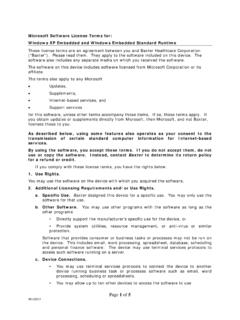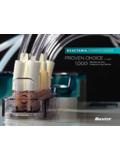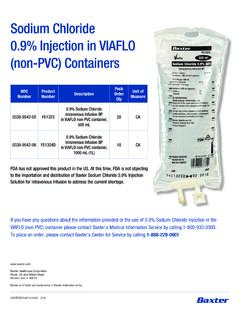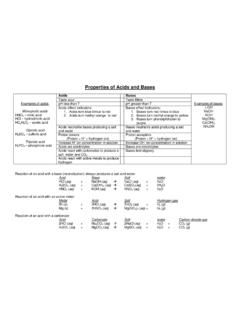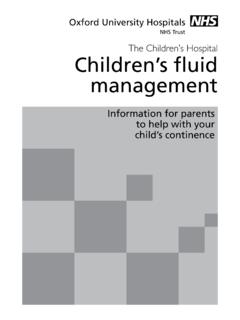Transcription of A parenteral nutrition solution with electrolytes
1 A parenteral nutrition solution with electrolytesCLINIMIX E Injections with electrolytes electrolyte profile is consistent with guidelines Can be used to treat most parenteral nutrition patients May reduce risk of medication errors related to compounding Available in 1 and 2-liter volumes Central and peripheral formulations Terminally sterilized, nonpyrogenic, hypertonic solution manufactured in a CLARITY dual-chamber container n Non-DEHP/Non-PVC n Non-latex Extended shelf life n 2 years room temperature (inactivated and in overwrap) n 9 days under refrigeration (activated, no additives) Multiple ports provide flexibility to include additives such as IV fat emulsion, vitamins or trace elements n Additives may be incompatible; consult with pharmacist, if availablePeel sealDextrose chamber (with calcium)Injection port (medications, trace elements, multivitamins)Sulfite-free Amino acid chamber (with electrolytes )Administration portAdditive port (IV fat emulsion)Good Manufacturing Practices (cGMP) Processn Regulations enforced by the FDA that assures safety and efficacy of drug The cGMPs are in place to prevent: n Sub-potency or super-potency n Contamination n Unpredictable safety or efficacy n Misbranding1.
2 Http:// 2. TinumalaiRandPorterDAPR. 2005, Vol Profile Information33333333 Terminally sterilized products represent the lowest risk of sterile pharmaceutical products2 Indications and UsageCLINIMIX E sulfite-free (Amino Acid with electrolytes in Dextrose with Calcium) Injections are indicated as a caloric component in a parenteral nutrition regimen and as the protein (nitrogen) source for offsetting nitrogen loss or for the treatment of negative nitrogen balance in patients where (1) the alimentary tract cannot or should not be used, (2) gastrointestinal absorption of protein is impaired, or (3) metabolic requirements for protein are substantially increased, as with extensive Risk Informationn It is essential that a carefully prepared protocol based on current medical practices be followed, preferably by an experienced team.
3 Frequent clinical evaluation and laboratory determinations are necessary for proper monitoring during administration. n clinimix E Injections are contraindicated in patients having intracranial or intraspinal hemorrhage, in patients who are severely dehydrated, in patients hypersensitive to one or more amino acids and in patients with severe liver disease or hepatic coma. Solutions containing corn-derived dextrose may be contraindicated in patients with known allergy to corn or corn products. n Because of the potential for life-threatening events, caution should be taken to ensure that precipitates have not formed in any parenteral nutrient admixture. n Use with caution when administering to patients with anuria or renal insufficiency, pulmonary insufficiency, or heart disease. The intravenous administration of these solutions can cause fluid and/or solute overloading resulting in dilution of serum electrolyte concentrations, overhydration, congested states, or pulmonary edema.
4 N Metabolic complications have been reported, such as acid-base, electrolyte , and blood glucose imbalances, elevated liver enzymes, and osmotic diuresis and dehydration. n Other adverse reactions that may occur include febrile response, infection at the site of injection, extravasation, and hypervolemia. The infusion of hypertonic nutrient injections into a peripheral vein may result in vein irritation, vein damage, and thrombosis. n This product contains aluminum that may be toxic with prolonged parenteral administration if kidney function is impaired. n clinimix E Injections must be admixed prior to refer to the enclosed full Prescribing errors can be a significant problemAccording to an survey, parenteral nutrition related practices can be inconsistent and lead to Contributing to some of these inconsistencies are the different conventions used to order electrolytes .
5 Considerations for electrolyte Management6, 7n electrolytes are tightly regulated by the kidneysn electrolyte levels can fluctuate over timen Micromanaging electrolyte intake may not be necessary in most patients with normal renal functionn Interventions should be made based on trends over time for mild to moderate imbalancesn It is essential that a carefully prepared protocol based on current medical practices be followed, preferably by an experienced team. Frequent clinical evaluation and laboratory determinations are necessary for proper monitoring during administrationNutrition and Electrolytesn Patients on parenteral nutrition usually receive maintenance electrolytes4n electrolytes in parenteral nutrition can be customized or standardized5n electrolytes are standardized in most EN formulations3. Seres D, et al.
6 JPEN J Parenter Enteral Nutr. 2006;30: 259-2654. Mirtallo J, et al. JPEN J Parenter Enteral Nutr. 2004;28(6):S39-705. Kochevar M., et al. JPEN J Parenter Enteral Nutr. 2007;31(5):441-86. Eaton DC, Pooler JP (2009). Vander s Renal Physiology, Seventh Edition. McGraw-Hill7. Heitz, U, et al. Pocket guide to fluid, electolyte, and acid-base balance, 5th ed, Chapter 3, Chapter 12, survey on PN ordering and compounding (n = 651) Electronic Survey was administered through the website Respondents - dietitians, nurses, pharmacists, 70% 60% 50% 40% 30% 20% 10% 0% PERCENT OF RESPONDENTSE lectrolytesInsulinDextroseParenteral nutrition components most often associated with errorn 71% of respondents associated electrolytes with the source of error in parenteral nutrition71%31%31%50% 40% 30% 20% 10% 0% PERCENT OF RESPONDENTSmEq/L or mEq/100 mLmEq/daymEq/total volumemEq/kgParenteral nutrition components most often associated with errorPhosphate example.
7 N 7% ordered millimoles of saltn 26% ordered mEq of the cationn 17% used both43%39%38%16%n suggests managing short-term electrolyte abnormalities with parenteral nutrition is inappropriate8 n Managing additional electrolyte needs outside of the parenteral nutrition bag is recommendedn In a 2005 prospective study to evaluate the effect of standardized vs. customized parenteral nutrition , patients receiving standardized formulations were more likely to have electrolyte values within normal limits9n PN Safety Summit recommends standardization of parenteral nutrition formulation processes to reduce risk of adverse eventsStandardized parenteral nutrition (PN) with electrolytes can be an appropriate choiceImportant Risk Informationn Use with caution when administering to patients with anuria or renal insufficiency, pulmonary insufficiency, or heart disease.
8 The intravenous administration of these solutions can cause fluid and/or solute overloading resulting in dilution of serum electrolyte concentrations, overhydration, congested states, or pulmonary Metabolic complications have been reported, such as acid-base, electrolyte , and blood glucose imbalances, elevated liver enzymes, and osmotic diuresis and refer to the Indications and detailed Important Risk Information on reverse refer to the enclosed Full Prescribing Information.* Individual dosing needs Daily electrolyte Guidelines for Adult parenteral nutrition * clinimix E Injections2 Liter Bag ContainsCalcium10 15 mEq9 mEqMagnesium8 20 mEq10 mEqPhosphorus20 40 mmol30 mmolSodium1 2 mEq/kg70 mEqPotassium1 2 mEq/kg60 mEq8. Sacks G, et al. nutrition Support Practice Manual 2nd Edition 20059. Hayes EM, et al. P 25:78-87* Pump displayed is for example only.
9 Rx , Clarity, clinimix E and the clinimix logo are trademarks of Baxter International other trademarks appearing herein are the property of their respective Healthcare Corporation, Route 120 and Wilson Road, Round Lake, IL 60073 801496A 5K 5/12 Medical ProductsTo place an order, contact your Baxter representative or call 888-229-0001 Visit to learn about a patient assistance program for parenteral nutrition patients. This program provides clinimix or clinimix E Injections at no charge during times of prescription coverage gaps for qualifying, under or non-insured, parenteral nutrition and ResourcesVisit to access a variety of helpful tools and resources along with complete prescribing information. E SULFITE-FREE (AMINO ACID WITH electrolytes IN DEXTROSE WITH CALCIUM) INJECTIONSCLINIMIX E E E E E E 5/152B77212B77405%15% E 5/202B77222B77415%20% E 5/252B77232B77425%25% AcidConcentrationDextrose (kcal/L)Mg++ (mEq/L)Osmolarity (mOsm/L)2 L Codeg Protein/LNa+ (mEq/L)Cl- (mEq/L)DextroseConcentrationg N2/LAc- (mEq/L)Ca++ (mEq/L)pH*1 L Codeg Dextrose/LK+ (mEq/L)HPO4 = (mmol/L)
10 Product Code*pH range = - E Injections Formulation ProfilesCLINIMIX E Injections Product ListingBAXTER CODEPRODUCT DESCRIPTIONAMERISOURCEBERGEN SAPAMERISOURCE BERGEN STARCARDINALMCKESSONMORRIS DICKSONHD SMITH2B7713 clinimix E 2 Liter1000122801207029892591181312N/AN/A2 B7714 clinimix E 2 Liter1000122901208829892671180561555656N /A2B7716 clinimix E 2 Liter10020030278465298928311741503498451 0438352B7717 clinimix E 2 Liter10001179011437298929111767264496291 8412952B7719 clinimix E 2 Liter1000118201145229893251177591858654N /A2B7721 clinimix E 5/15 2 Liter10020010278218298933311785819509491 8413112B7722 clinimix E 5/20 2 Liter10024385358770298935811791756744991 8413292B7723 clinimix E 5/25 2 Liter10019431268417298936611800339782621 8413372B7735 clinimix E 1 Liter10045874702086345032714013634696681 8413452B7736 clinimix E 1 Liter1005089478386534764471403419986547N /A2B7737 clinimix E 1 Liter10045875702098344456911148755082341 4643202B7738 clinimix E 1 Liter10045876702105345033511149339527131 4643382B7739 clinimix E 1 Liter10045877702112344458511149584695691 6022832B7740 clinimix E 5/15 1 Liter10050890783840348371614063549782881 8413602B7741 clinimix E 5/20 1 Liter10050892783858347646214102992059061 8413782B7742 clinimix E 5/25 1 Liter1004999777119434837241413194978619N /ABaxter, clinimix E and clinimix E Logo are trademarks of Baxter International Inc.



